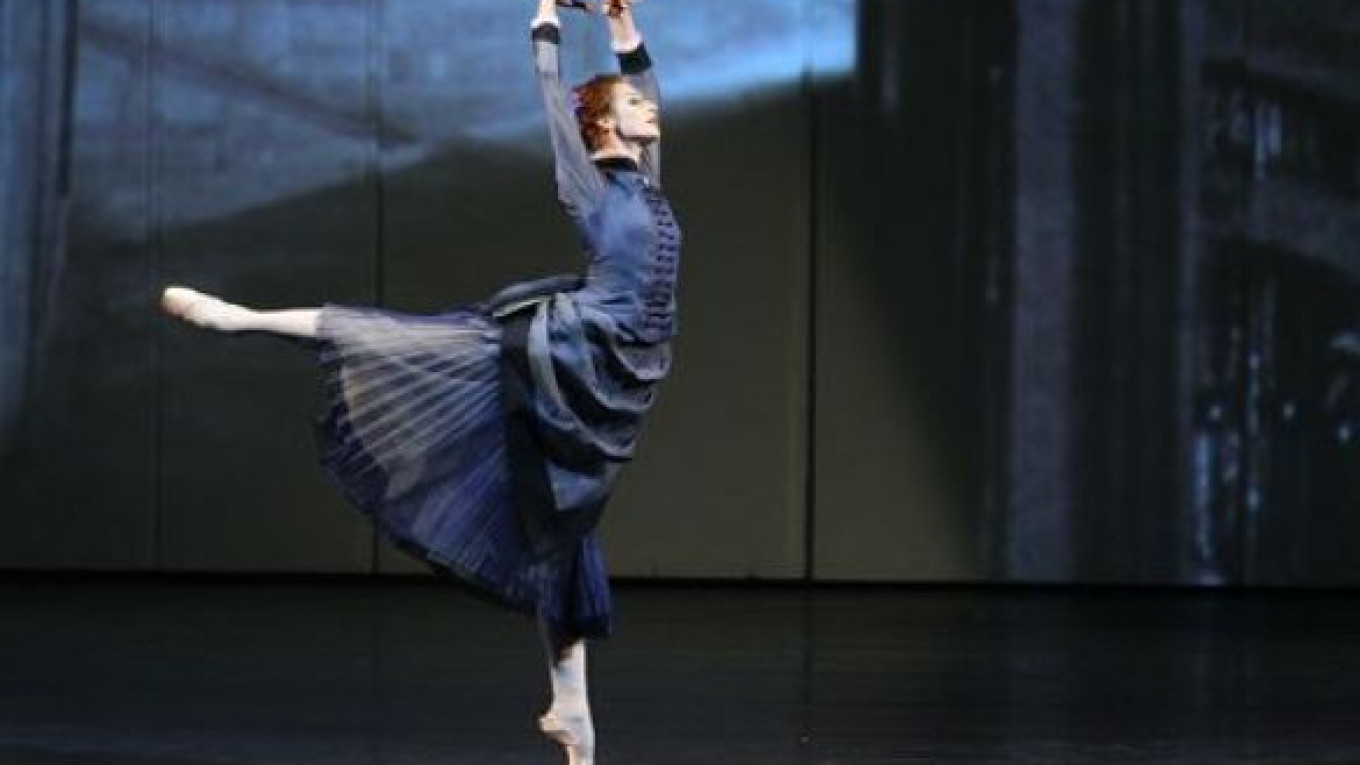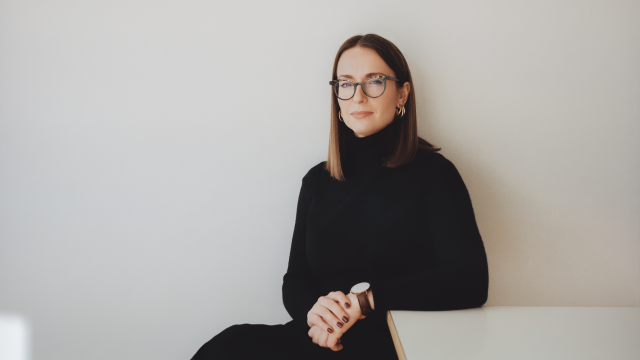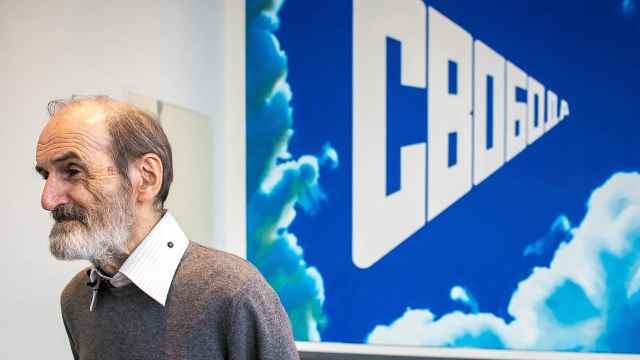ST. PETERSBURG — Somewhere at home Yekaterina Kondaurova still has her first pointe shoes, soaked in blood. Back in Moscow, where she was born, she joined a dance class as a child. The ballerina remembers the class when the girls stood en pointe for the first time.
“Our teacher simply commanded, ‘Stand up!’ and we put our pointe shoes on our bare feet and started the class,” she recalled. “At the end of the lesson the slippers were covered in blood. … I could never throw those pointes away. They are a very touching reminder of childhood.”
Today, Mariinsky ballet soloist Kondaurova thrives on eccentricity, her most successful heroines being tormented heroines of the likes of Anna Karenina, the vindictive Princess Gamsatti in “La Bayadere” and Alma Schindler in “Glass Heart,” the story of a love triangle between Alma, her husband — the composer Gustav Mahler — and her teacher, composer Alexander Zemlinsky.
In November, the lead role in Alexei Ratmansky’s ballet “Anna Karenina” won the 26-year-old dancer a Golden Sofit, St. Petersburg’s most prestigious theater prize, as well as a nomination for a Golden Mask, Russia’s most important theater award.
The dancer feels somewhat torn apart by this heroine: She is both loved, as well as misunderstood.
“Anna appears to be an egocentric person, too trapped in the cycle of her suffering,” Kondaurova said. “Of course, you can and should feel sympathy for her difficult situation, but nevertheless she demanded too much attention from those around her. In taking certain decisions, Anna only ever listened to the emotions that overwhelmed her, considering only herself. ‘How ill I am.’ ‘How unhappy I am.’ She is unable to distance herself from these thoughts that gnaw at her soul. But all of this may be explained by the subtlety of her nature, her extreme sensitivity and emotionality and her very delicate mental makeup. She finds it extremely difficult to overcome her own nature. And, of course, her addiction to morphine played its part.”
Tolstoy’s novel “Anna Karenina” forms part of the national school curriculum, yet Kondaurova scarcely remembers what she felt when she first opened the pages of the book about 10 years ago.
It was while working on the ballet that the dancer rediscovered the novel. “The truth is that I can’t even recall what sensations I experienced when I read the book at school,” she recalled. “It was compulsory reading, but somehow it passed me by. When pupils read this work at school, they have insufficient life experience and emotional knowledge to make sense of the tragic story that Tolstoy tells us. Alexei Ratmansky has created an immense and painstaking work that is sensitive toward Tolstoy’s ideas. All of the ballet’s mise en scenes have something in common with the protagonists’ monologues and what they say to one another. When you follow the movements that Alexei has crafted, you are almost literally reading Anna Karenina.”
The ballet genuinely gripped the dancer, who was given the opportunity to convey the mass of contradictions that tear Anna to pieces. “Anna is on the threshold of death, utterly powerless and devoid of energy when she realizes, at last, that she has found the true love that she has sought so long,” Kondaurova said.
“Alone with Vronsky, she is unbelievably feminine and vulnerable, but then her inner conflict and the desire to retrieve her position in society begin to destroy her. There are many different shades in my portrait of the heroine. It is very hard to take the performance right to the end without losing the tension and yet at the same time not losing your mind — these incredibly powerful emotions must be conveyed in every mise en scene.
“In this respect, Anna has something in common with my favorite character: Alma, the female protagonist in Kirill Simonov’s ballet ‘Glass Heart,’” the dancer said.
In Kondaurova’s opinion, the two women are united by their eccentricity and their ability to retain their inner selves. The difference, in turn, lies in the fact that in Anna there is an inner struggle. She tries to overcome her dependence on society and fails miserably.
“Alma is very close to me in terms of spirit, and she remains my favorite character, despite the fact that this ballet unfortunately hasn’t been in the repertoire for some time,” the ballerina said. “Sometimes I think that in my Anna, you can see Alma.”
With such an emotional connection to the characters that she dances, isn’t the ballerina afraid of burnout?
“I have seen many examples of professional burnout,” she replied thoughtfully, admitting that she has given the issue serious consideration. “Giving themselves without stopping is something that people can’t endure, and they suffer breakdowns. But this happens in instances when the person is unable to switch off from thinking about work and immerse themselves in their roles day and night. I believe that I have a more balanced attitude to my profession. I know how to relax, and I am not fixated by the stage alone.”
The role that Kondaurova, who has danced a wealth of classical roles, in addition to modern classics, dreams of with bated breath is, somewhat unexpectedly, that of Death in Roland Petit’s ballet “Le jeune homme et la mort.” This has been Kondaurova’s unfulfilled dream for years now. The ballerina has seen the ballet many times, and says it is a production that moves her deeply. “It’s not just the movements that Death makes, it’s the heroine’s unique image. Petit’s Death is a very subtle, remote and inspired woman,” she explained.
Kondaurova admits that she has been starved of contemporary dance and would really like to dance some roles in ballets by modern choreographers — a feeling shared by many of her colleagues in the Mariinsky troupe. In the meantime, Giselle remains one of the few classical roles that Kondaurova has not yet performed. The dancer, known for her voracious professional appetite, admits that she nurtures dreams of one day dancing even two iconic versions of Giselle — those of both Marius Petipa and Mats Ek.
“I would absolutely love the chance to dance both ballets, and one soon after the other so that there would be a chance to demonstrate the contrast. Mats Ek’s Giselle is more corporeal and palpable,” she said.
Yekaterina Kondaurova next performs on Jan. 5 in “Le Corsaire” (in the role of Medora), and then on Jan. 16 in Spartacus (as Phrygia). Mariinsky Theater. St. Petersburg.
A Message from The Moscow Times:
Dear readers,
We are facing unprecedented challenges. Russia's Prosecutor General's Office has designated The Moscow Times as an "undesirable" organization, criminalizing our work and putting our staff at risk of prosecution. This follows our earlier unjust labeling as a "foreign agent."
These actions are direct attempts to silence independent journalism in Russia. The authorities claim our work "discredits the decisions of the Russian leadership." We see things differently: we strive to provide accurate, unbiased reporting on Russia.
We, the journalists of The Moscow Times, refuse to be silenced. But to continue our work, we need your help.
Your support, no matter how small, makes a world of difference. If you can, please support us monthly starting from just $2. It's quick to set up, and every contribution makes a significant impact.
By supporting The Moscow Times, you're defending open, independent journalism in the face of repression. Thank you for standing with us.
Remind me later.






